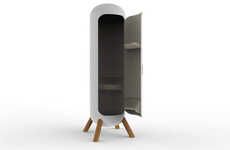Analeptic
References: moma.org & curatedobject.us
The well-being and productivity of workers is essential for the success of any enterprise. Analeptic is a project by French designer Marie-Virginie Berbet that aims to guarantee optimal physiological conditions at the workplace. She has developed two devices for the project.
The first, Narco, is a cell for napping. The interior of the cocoon consists of a series of strips that provide visual and sound insulation from the surroundings. Also the hammock-like position suggests levitation. The cell detects the exact moment the user falls asleep, and ten minutes later—enough time to be restorative but before deep sleep sets in—the cocoon's strips begin emitting a soft yet stimulating light. Perfect for a short productive nap.
Cyclo, the second part of Berbet's Analeptic project, is a desk blotter with behavioral and physiological sensors and a rotating light with interdependent strips that switch on and off in sequence. The intensity of the light and the speed of the switching and rotation vary according to the user's stimulation and activity levels. At normal levels the light turns slowly. When the user is hyperactive, the light turns fast and then progressively slows, inducing the user to relax and chill. Conversely, If the user is sleepy or fatigued, the light stops turning. Its intensity rises in the front strips to provide a screen of blue light that blocks melatonin secretion and enhances the arousal level.
The first, Narco, is a cell for napping. The interior of the cocoon consists of a series of strips that provide visual and sound insulation from the surroundings. Also the hammock-like position suggests levitation. The cell detects the exact moment the user falls asleep, and ten minutes later—enough time to be restorative but before deep sleep sets in—the cocoon's strips begin emitting a soft yet stimulating light. Perfect for a short productive nap.
Cyclo, the second part of Berbet's Analeptic project, is a desk blotter with behavioral and physiological sensors and a rotating light with interdependent strips that switch on and off in sequence. The intensity of the light and the speed of the switching and rotation vary according to the user's stimulation and activity levels. At normal levels the light turns slowly. When the user is hyperactive, the light turns fast and then progressively slows, inducing the user to relax and chill. Conversely, If the user is sleepy or fatigued, the light stops turning. Its intensity rises in the front strips to provide a screen of blue light that blocks melatonin secretion and enhances the arousal level.
Trend Themes
1. Optimizing Workplace Wellness - Opportunities include creating personalized wellness plans for employees and developing technology to monitor and improve physiological conditions at work.
2. Innovative Workspace Design - Companies can explore designing workspaces that promote creativity and productivity, such as implementing private nap pods and flexible seating options.
3. Technology-assisted Relaxation - Disruptive innovation opportunities include creating wearable technology that helps users relax and destress, as well as developing virtual reality relaxation experiences.
Industry Implications
1. Office Furniture Manufacturing - Companies in this industry can explore creating ergonomic furniture that promotes physical wellness and productivity, such as adjustable desks and ergonomic chairs.
2. Employee Wellness - Opportunities exist in developing employee wellness programs that focus on physical and mental health, including on-site workout classes and meditation sessions.
3. Sleep Tech - Companies in this industry can explore developing technology that improves sleep quality, such as smart mattresses and sleep tracking devices.
2.1
Score
Popularity
Activity
Freshness






















